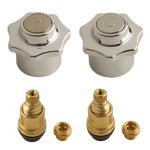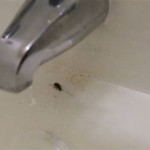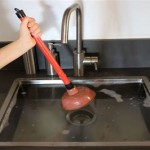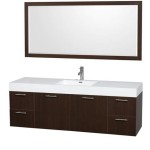Bathroom Sink Filling With Water By Itself
If you've noticed your bathroom sink filling with water by itself, it's essential to investigate the cause promptly. While it may seem like a minor issue, it can indicate an underlying plumbing problem that requires attention.
Causes of a Self-Filling Bathroom Sink
- Faulty Shut-Off Valve: The shut-off valve beneath the sink is responsible for controlling water flow to the faucet. A worn or damaged valve may not seal correctly, allowing water to seep through even when the faucet is turned off.
- Leaking Supply Line: The supply lines connect the shut-off valves to the faucet. Over time, they can become cracked or loose, leading to leaks. These leaks can cause water to drip into the sink, filling it up gradually.
- Clogged Drain: A clogged drain can prevent water from draining properly. As a result, water may back up into the sink, filling it up.
- Siphoning Effect: In rare cases, a siphoning effect can occur if the drain is located below the level of the water in the sink. This creates a vacuum that draws water from the sink into the drainpipe.
Troubleshooting and Fixes
- Check the Shut-Off Valve: Turn off the water supply to the sink using the shut-off valve. If the water in the sink stops rising, the problem likely lies with the valve. Replace it with a new one.
- Inspect the Supply Lines: Examine the supply lines for any leaks or cracks. If you find any damage, replace the affected line.
- Unclog the Drain: Use a drain snake or chemical drain cleaner to clear any clogs in the drain. Once the clog is removed, the water should drain properly.
- Correct Siphoning: If a siphoning effect is suspected, you may need to install an anti-siphon device on the drainpipe.
Prevention Tips
- Regular Inspections: Regularly inspect your bathroom sink and plumbing fixtures for any signs of leaks or damage.
- Proper Installation: Ensure that all plumbing fixtures and valves are installed correctly by a qualified plumber.
- Avoid Harsh Chemicals: Avoid using harsh chemicals in your drains, as they can corrode pipes and fittings.
- Call a Plumber: If you are unable to identify or fix the cause of your self-filling bathroom sink, contact a licensed plumber for professional assistance.
Conclusion
A bathroom sink filling with water by itself can be a nuisance and a potential source of water damage. By understanding the common causes and following the troubleshooting tips outlined above, you can effectively address this issue and prevent it from reoccurring. If the problem persists or is beyond your ability to fix, do not hesitate to seek the assistance of a qualified plumber.Why Does A Bathroom Sink Fill Up From The Drain When There Is No Running Water Quora

How To Unclog Bathroom Sink A Guide For Your Home
How To Unclog A Stubborn Drain In My Bathroom Sink Quora
Why Does A Bathroom Sink Drain Slowly Quora

Cloudy Hot Water Coming From One Faucet
Every 10 Days Or So My Bathroom Sink Becomes Dirty With Some Sort Of Black Grayish Metallic Powder That Back Flushes Up From The Drain What Is This And How Can I Prevent Fix

How To Unblock A Bathroom Sink Sanctuary Bathrooms

How To Unclog Bathroom Sink A Guide For Your Home
Every 10 Days Or So My Bathroom Sink Becomes Dirty With Some Sort Of Black Grayish Metallic Powder That Back Flushes Up From The Drain What Is This And How Can I Prevent Fix

How To Fix A Dripping Bathroom Faucet







